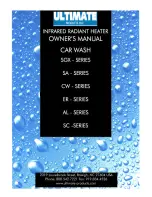
– 30 –
G. Heater
1. At least a yearly inspection is recommended
for heating installations and more frequently
for process applications in year-round
operation. Your own experience is the best
guide in determining frequency of inspection,
but as a minimum the following procedure
should be followed:
a. Shut the system down totally, disconnect-
ing or locking out power supply so there
can be no accidental start-up during
inspection.
b. Inspect the burner carefully, including
upstream and downstream sides of mixing
plates as well as burner body face. Note
that complete burner assembly may have
to be removed for proper inspection and
cleaning. Any accumulation of scale or
foreign material on either side of the
mixing plates should be removed with a
wire brush. Check visually that no holes in
the mixing plates are blocked. If any
burner ports are plugged (even partially)
clear them with a piece of wire. See
Maintenance of Gas Ports.
WARNING: Do not enlarge burner ports or
performance may be drastically affected.
If any mixing plates are loose or missing
fasteners, tighten/replace as necessary.
Always use zinc plated or stainless
fasteners.
The mixing plates on the burner may display
“hairline” cracks. These cracks are normal, and
caused by thermal stresses occurring during
combustion. The presence of these “hairline”
cracks in no significant way affects the combus-
tion efficiency or performance of the heater.
Should a large opening develop, it may cause
difficulties in cross ignition of flame across the
face of the burner. If this does occur, the specific
mixing plate or plates involved must be replaced.
c. Put system back into operation and view burner
while cycling through full firing range. This will
give a visual check for blocked burner ports.
2. Inspect the flame rod and ignition electrode for dirt
and moisture. Wipe off if necessary. Examine for
any evidence of premature arcing. If in doubt, check
continuity of flame rod to be sure it is not grounding
out. Replace if required.
The porcelain on the ignition electrode must be
intact - not cracked. The spark gap should be
between 1/16 and 3/32 of an inch.
3. Replace all access panels which have been removed
and operate the unit for a test period. Check for
normal response and function of all controls.
4. Check all gas piping for possible leaks using a soap
bubble solution.
5. Inspect the support means to be sure that every-
thing is firmly anchored in place.
MAXON NP-I AIRFLO
®
BURNERS
Inspection and Maintenance of Gas Ports
Conduct initial inspection within the first month
after commissioning. Visually check the gas ports
of new burner assemblies for any piping scale or
debris. Use Pin Vise with drill bit to remove.
Annual inspections are normally adequate once
the initial piping debris is removed. The operating
conditions of the burner will determine how
frequently maintenance is actually required.
Use of an electric drill motor is not suggested
unless both Pin Vise and Drill (as shown) can be
chucked up in a vari-speed drill unit. Use caution,
because it is easy to snap the bits off in a port
when using a drill motor. Removal of broken bits
from the gas ports is difficult.
Alternate drill sizes which may be used are 5/64"
(for #47) and 1/16" (for #50).
Contact your Maxon representative to answer
questions or address any problems.
Summary of Contents for SDFI
Page 20: ...20 TROUBLESHOOTING GUIDE P 001004 P 001003...
Page 35: ...35...







































